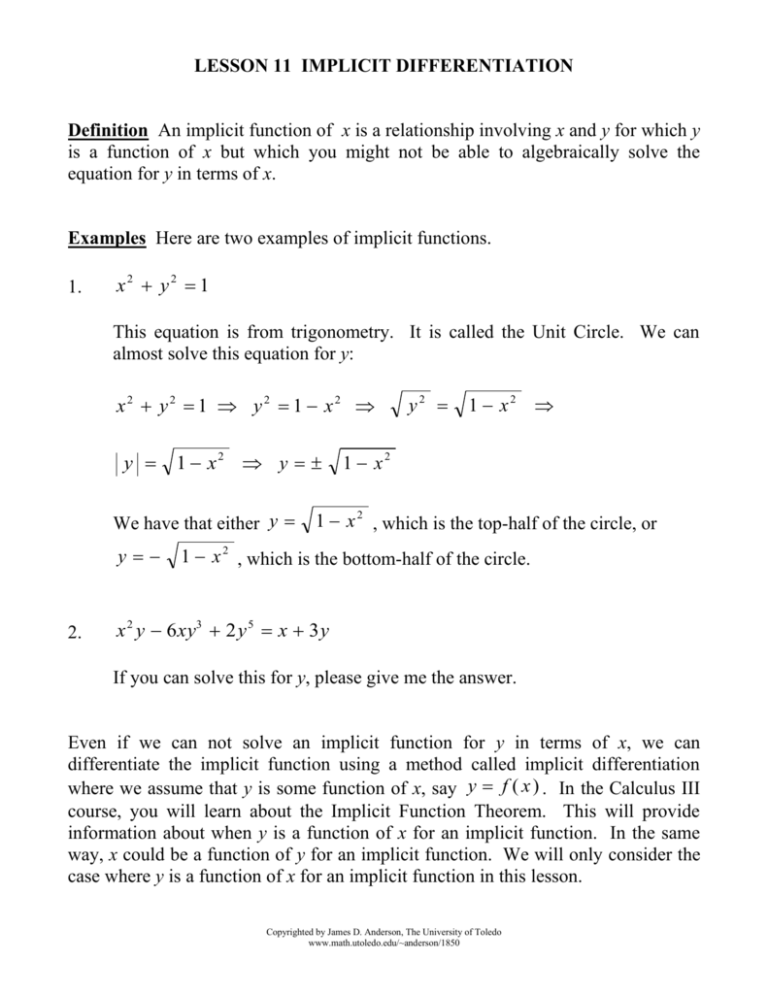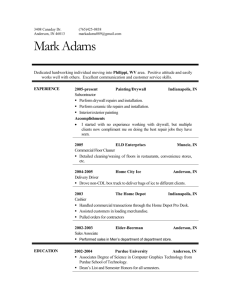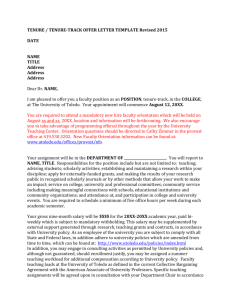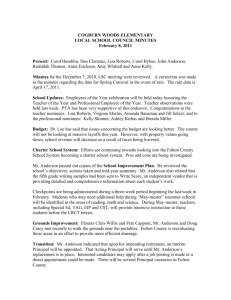Lesson 11 Implicit Differentiation
advertisement

LESSON 11 IMPLICIT DIFFERENTIATION Definition An implicit function of x is a relationship involving x and y for which y is a function of x but which you might not be able to algebraically solve the equation for y in terms of x. Examples Here are two examples of implicit functions. 1. x2 y2 1 This equation is from trigonometry. It is called the Unit Circle. We can almost solve this equation for y: x2 y2 1 y 2 1 x2 y 1 x2 y We have that either y y 2. y2 1 x2 1 x2 1 x 2 , which is the top-half of the circle, or 1 x 2 , which is the bottom-half of the circle. x 2 y 6 xy3 2 y 5 x 3 y If you can solve this for y, please give me the answer. Even if we can not solve an implicit function for y in terms of x, we can differentiate the implicit function using a method called implicit differentiation where we assume that y is some function of x, say y f ( x ) . In the Calculus III course, you will learn about the Implicit Function Theorem. This will provide information about when y is a function of x for an implicit function. In the same way, x could be a function of y for an implicit function. We will only consider the case where y is a function of x for an implicit function in this lesson. Copyrighted by James D. Anderson, The University of Toledo www.math.utoledo.edu/~anderson/1850 Implicit differentiation is an application of the Chain Rule. 2 2 Example Differentiate x y 1 using implicit differentiation assuming that y is a function of x. In the first example above, we showed that either y Thus, y f ( x ) , where either f ( x ) 1 x 2 or y 1 x 2 or f ( x ) 1 x2 . 1 x2 . In order to see how the Chain Rule is used, let’s replace y in the equation x 2 y 2 1 by f ( x ) . Thus, we have that x 2 [ f ( x ) ]2 1 . Note, that by the 2 Chain Rule, we have that D x [ f ( x ) ] 2 [ f ( x ) ] Dx f ( x ) = 2[ f ( x ) ] f ( x ) . X X 2 2 Since y f ( x ) , then Dx [ f ( x ) ] 2 [ f ( x ) ] f ( x ) D x ( y ) 2 y y . 2 2 Since D x ( x ) 2 x , D x ( y ) 2 y y , Dx (1) 0 , then we have that x2 y X 2 1 2x 2 y y 0 2 ( x y y ) 0 x y y 0 y y x y Answer: y x y x y Examples Differentiate the following functions (assuming that y is a function of x.) 1. 3x 2 4 y 5 12 3x 2 4 y X 5 12 6 x 20 y 4 y 0 6 x 20 y 4 y Copyrighted by James D. Anderson, The University of Toledo www.math.utoledo.edu/~anderson/1850 y 6x 3x y 20 y 4 10 y 4 Answer: y 2. 3x 10 y 4 5x 2 xy 3 y 4 x 3 NOTE: When it comes time to differentiate the term xy , you will need to use the Product Rule to differentiate this product. We will not need to use the Chain Rule to find Dx ( y ) , the derivative of y with respect to x, since by dy y . definition, D x ( y ) dx 5x 2 x y 3 y X 4 x 3 10 x (1 y xy ) 12 y 3 y 3x 2 10 x y xy 12 y3 y 3x 2 xy 12 y 3 y 3x 2 10 x y 3x 2 10 x y y ( x 12 y ) 3x 10 x y y x 12 y 3 3 2 3x 2 10 x y Answer: y x 12 y 3 3. x3 2x 2 y 3 y 5 x 4 y x3 2x 2 y 3 y X X 5 x4 y 3x 2 2 ( 2 xy3 x 2 3 y 2 y ) 5 y 4 y 4 x 3 y 3x 2 4 xy3 6 x 2 y 2 y 5 y 4 y 4 x 3 y Copyrighted by James D. Anderson, The University of Toledo www.math.utoledo.edu/~anderson/1850 6 x 2 y 2 y 5 y 4 y y 4 x 3 3x 2 4 xy3 y ( 6 x 2 y 2 5 y 4 1) 4 x 3 3x 2 4 xy3 4 x 3 3x 2 4 xy3 y 6x 2 y 2 5 y 4 1 Answer: 4. 4 x 3 3x 2 4 xy3 y 6x 2 y 2 5 y 4 1 x 4 6 xy7 3 y 2 2 x 5 y 5 8 x 4 6 xy X 7 3y X 2 2x5 y X 5 8 4 x 3 6 ( y 7 x 7 y 6 y ) 6 yy 10 x 4 5 y 4 y 4 x 3 6 y 7 42 xy6 y 6 yy 10 x 4 5 y 4 y 4 x 3 6 y 7 10 x 4 5 y 4 y 42 xy6 y 6 yy 4 x 3 6 y 7 10 x 4 y ( 5 y 4 42 xy6 6 y ) 4 x 3 6 y 7 10 x 4 y 4 5 y 42 xy6 6 y 4 x 3 6 y 7 10 x 4 Answer: y 5 y 4 42 xy6 6 y 5. ( y 2 9 ) 4 ( 4 x 2 3 x 1) 3 2 4 2 3 NOTE: Dx ( y 9 ) 4 ( y 9 ) Dx ( y X X 2 9 ) = 4 ( y 2 9 ) 3 2 yy = Copyrighted by James D. Anderson, The University of Toledo www.math.utoledo.edu/~anderson/1850 8 yy ( y 2 9 ) 3 and Dx ( 4 x 2 3x 1) 3 3 ( 4 x 2 3x 1) 2 ( 8 x 3 ) . Thus, X ( y 2 9 ) 4 ( 4 x 2 3 x 1) 3 8 yy ( y 2 9 ) 3 3 ( 4 x 2 3x 1) 2 ( 8x 3 ) 3 ( 4 x 2 3 x 1) 2 ( 8 x 3 ) y 8 y ( y 2 9 )3 3 ( 4 x 2 3 x 1) 2 ( 8 x 3 ) Answer: y 8 y ( y 2 9 )3 6. 6x 2 y 3x 2 y4 5 6x 2 y 3x 2 y 4 5 X 12 x ( y 4 5 ) 6 x 2 4 y 3 y y 3 ( y 4 5)2 12 x ( y 4 5 ) 24 x 2 y 3 y 4 2 ( y 5) y 3( y 5) 4 2 ( y 5) 4 2 12 x ( y 4 5 ) 24 x 2 y 3 y y ( y 4 5 ) 2 3 ( y 4 5 ) 2 24 x 2 y 3 y y ( y 4 5 ) 2 3 ( y 4 5 ) 2 12 x ( y 4 5 ) y [ ( y 4 5 ) 2 24 x 2 y 3 ] 3 ( y 4 5 ) 2 12 x ( y 4 5 ) 3 ( y 4 5 ) 2 12 x ( y 4 5 ) y ( y 4 5 ) 2 24 x 2 y 3 Copyrighted by James D. Anderson, The University of Toledo www.math.utoledo.edu/~anderson/1850 3 ( y 4 5 ) 2 12 x ( y 4 5 ) Answer: y ( y 4 5 ) 2 24 x 2 y 3 7. 4 x4 y 4 7x3 y 6 ( x 4 y 4 )1 / 4 7 x 3 y 6 4 4 1/ 4 NOTE: Dx ( x y ) X 1 4 ( x y 4 ) 3 / 4 Dx ( x 4 y 4 ) = 4 X 1 4 ( x y 4 ) 3 / 4 ( 4 x 3 4 y 3 y ) = ( x 4 y 4 ) 3 / 4 ( x 3 y 3 y ) 4 3 6 2 6 3 5 2 6 3 5 and Dx ( 7 x y ) 21x y 7 x 6 y y = 21x y 42 x y y Thus, ( x 4 y 4 )1 / 4 7 x 3 y 6 ( x 4 y 4 ) 3 / 4 ( x 3 y 3 y ) 21x 2 y 6 42 x 3 y 5 y ( x 4 y 4 ) 3 / 4 [ ( x 4 y 4 ) 3 / 4 ( x 3 y 3 y ) ] ( x 4 y 4 ) 3 / 4 ( 21x 2 y 6 42 x 3 y 5 y ) x 3 y 3 y 21x 2 y 6 ( x 4 y 4 ) 3 / 4 42 x 3 y 5 y( x 4 y 4 ) 3 / 4 x 3 21x 2 y 6 ( x 4 y 4 ) 3 / 4 42 x 3 y 5 y( x 4 y 4 ) 3 / 4 y 3 y x 3 21x 2 y 6 ( x 4 y 4 ) 3 / 4 y[ 42 x 3 y 5 ( x 4 y 4 ) 3 / 4 y 3 ] x 3 21x 2 y 6 ( x 4 y 4 ) 3 / 4 y 42 x 3 y 5 ( x 4 y 4 ) 3 / 4 y 3 Copyrighted by James D. Anderson, The University of Toledo www.math.utoledo.edu/~anderson/1850 x 3 21x 2 y 6 ( x 4 y 4 ) 3 / 4 Answer: y 42 x 3 y 5 ( x 4 y 4 ) 3 / 4 y 3 8. 3 xy 2 27 x 4 y Since x1 / 3 y X 3 xy 2 ( xy 2 )1 / 3 x1 / 3 y 2 / 3 , then we have that 2/3 27 x 4 y 1 2/3 2/3 2 x y x1 / 3 y 1 / 3 y ( 4 x 3 y x 4 y ) 3 3 2 1 3 x 2 / 3 y 1 / 3 x 2 / 3 y 2 / 3 x1 / 3 y 1 / 3 y 3 x 2 / 3 y 1 / 3 ( 4 x 3 y x 4 y ) 3 3 y 2 xy 12 x11/ 3 y 4 / 3 3x14 / 3 y1 / 3 y 2 xy 3x14 / 3 y1 / 3 y 12 x11/ 3 y 4 / 3 y y ( 2 x 3x14 / 3 y1 / 3 ) 12 x11/ 3 y 4 / 3 y 12 x11/ 3 y 4 / 3 y y 2 x 3x14 / 3 y 1 / 3 12 x11/ 3 y 4 / 3 y 12 x11/ 3 y 4 / 3 y Answer: y or y 14 / 3 1 / 3 2 x 3x14 / 3 y1 / 3 2 x 3x y Here is another way that this problem can be worked: 3 xy 2 27 x 4 y ( xy2 )1 / 3 27 x 4 y Copyrighted by James D. Anderson, The University of Toledo www.math.utoledo.edu/~anderson/1850 2 1/ 3 NOTE: Dx ( xy ) X 1 1 ( xy 2 ) 2 / 3 Dx ( xy 2 ) = ( xy 2 ) 2 / 3 ( y 2 x 2 yy ) = 3 3 X 1 2/3 4/3 1 (x y ) ( y 2 2 xyy ) = ( x 2 / 3 y 4 / 3 ) y ( y 2 xy ) = 3 3 1 2 / 3 1/ 3 (x y ) ( y 2 xy ) Thus, 3 ( xy2 )1 / 3 27 x 4 y 1 2 / 3 1/ 3 (x y ) ( y 2 xy ) ( 4 x 3 y x 4 y ) 3 1 3x 2 / 3 y 1 / 3 ( x 2 / 3 y 1 / 3 ) ( y 2 xy ) 3x 2 / 3 y 1 / 3 ( 4 x 3 y x 4 y ) 3 y 2 xy 12 x11/ 3 y 4 / 3 3x14 / 3 y1 / 3 y 2 xy 3x14 / 3 y1 / 3 y 12 x11/ 3 y 4 / 3 y y ( 2 x 3x14 / 3 y1 / 3 ) 12 x11/ 3 y 4 / 3 y 12 x11/ 3 y 4 / 3 y y 2 x 3x14 / 3 y 1 / 3 Example Find the equation (in point-slope form) of the tangent line to the graph of 2 x 3 x 2 y y 3 1 0 at the point ( 2 , 3 ) . 2 x 3 x 2 y y 3 1 0 6 x 2 ( 2 xy x 2 y ) 3 y 2 y 0 x 2 , y 3 : 24 ( 12 4 y ) 27 y 0 NOTE: y in this equation is actually y ( 2 , 3 ) . However, to write y ( 2 , 3 ) in the equation would produce an equation that would be more difficult to work with. Thus, we write y instead. Copyrighted by James D. Anderson, The University of Toledo www.math.utoledo.edu/~anderson/1850 24 ( 12 4 y ) 27 y 0 24 12 4 y 27 y 0 23y 36 y Answer: y 3 36 23 Thus, mtan y ( 2 , 3 ) 36 23 36 ( x 2) 23 Example Find the slope of the normal line to the graph of y 4 3 y 4 x 3 5x 31 at the point ( 1, 2 ) . y 4 3 y 4 x 3 5x 31 4 y 3 y 3 y 12 x 2 5 x 1, y 2 : 32 y 3 y 12 5 NOTE: y in this equation is actually y ( 1, 2 ) . However, to write y ( 1, 2 ) in the equation would produce an equation that would be more difficult to work with. Thus, we write y instead. 32 y 3 y 12 5 29y 17 y Thus, mtan y ( 1, 2 ) 17 29 17 29 mnormal 29 17 29 Answer: 17 The proof of the Power Rule for rational exponents: We will now give the proof of the Power Rule for rational exponents using implicit differentiation and the Power Rule for positive and negative integer exponents. The Power Rule for positive integer exponents was proved in Lesson 8, and the Power Rule for negative integer exponents was proved in Lesson 9. Copyrighted by James D. Anderson, The University of Toledo www.math.utoledo.edu/~anderson/1850 Let y x m x m / n , where n is a positive integer and m is an integer (positive or m m/n 1 m/n n m negative). We want to show that y x . Since y x , then y x . n m xm 1 n 1 m 1 y Using implicit differentiation, we have that n y y m x . n yn 1 n Since y x m xm 1 nx m ( n 1) n m/n m xm 1 m xm 1 y , then we have that y = n yn 1 n ( xm / n )n 1 m m 1 (m m/ n) m m 1 m m/n m m/n 1 m xm 1 x x = = n = n = n x . n xm m/ n Copyrighted by James D. Anderson, The University of Toledo www.math.utoledo.edu/~anderson/1850







